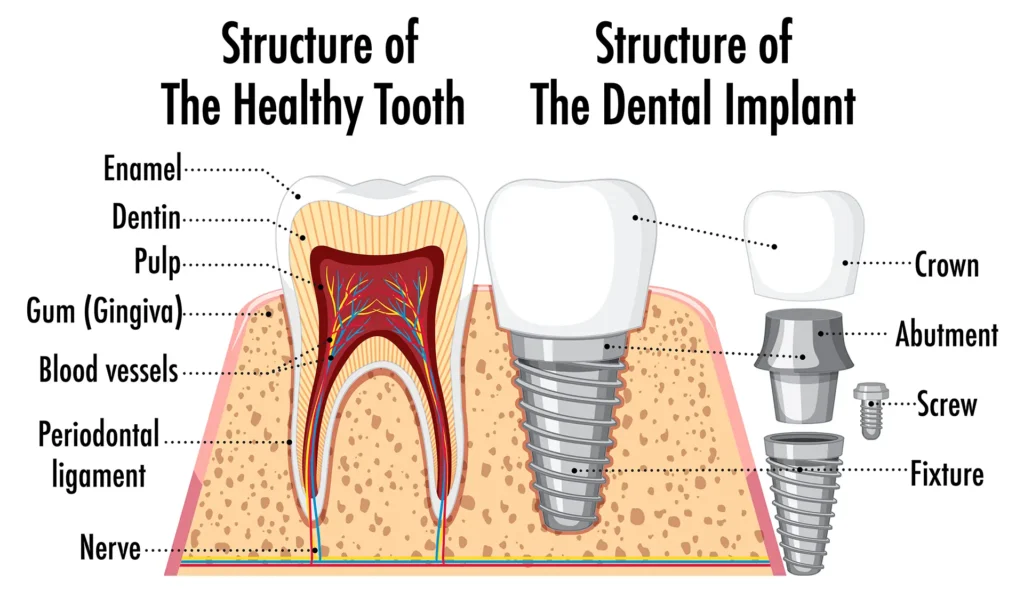Dental implants are a popular and effective solution for replacing missing teeth. They offer a long-term solution that looks, feels, and functions like natural teeth. If you’re considering dental implants, it’s essential to understand the process involved. This guide will take you through the procedure step by step, ensuring you’re well-informed about what to expect.

Introduction to Dental Implants Procedure Step by Step
Dental implants have revolutionized the field of dentistry, providing a durable and aesthetically pleasing option for those who have lost teeth due to injury, disease, or decay. This article aims to explain the procedure step by step, giving you a clear understanding of each phase, from the initial consultation to the final restoration.
Understanding Dental Implants
Dental implants are titanium posts that are surgically placed into the jawbone beneath the gum line. These posts act as artificial tooth roots, providing a stable foundation for replacement teeth. The procedure involves several stages, each crucial for ensuring the longevity and success of the implant.
Initial Consultation and Assessment
The first step in the procedure step by step is the initial consultation. During this visit, your dentist will:
- Evaluate Your Oral Health: A thorough examination of your mouth, including X-rays and 3D imaging, to assess the health of your jawbone and surrounding structures.
- Medical History Review: Discuss your medical history, including any medications you are taking and any chronic health conditions you may have.
- Treatment Planning: Based on the evaluation, your dentist will develop a personalized treatment plan, including the number of implants needed and the type of restoration.
Bone Grafting (If Needed)
Some patients may not have enough healthy bone in their jaw to support dental implants. If this is the case, a bone graft may be necessary. This involves adding bone material to the jawbone to create a solid foundation. The graft material can come from another part of your body or a synthetic source.
Dental Implant Placement
Once your jawbone is ready, the next step in the procedure is surgically placing the implants. This involves:
- Administering Anesthesia: To ensure comfort during the procedure, your dentist will administer local anesthesia or sedation.
- Incision and Drilling: A small incision is made in the gum tissue to expose the jawbone. Your dentist will then drill a hole into the bone where the implant will be placed.
- Inserting the Implant: The titanium post is inserted into the drilled hole, and the gum tissue is stitched back into place.
- Healing Period: After the implant is placed, a healing period of several months is required to allow the implant to fuse with the bone in a process called osseointegration.
Osseointegration and Healing
Osseointegration is a critical phase. During this period:
- Bone Fusion: The implant gradually fuses with the jawbone, creating a strong and stable anchor for the replacement tooth.
- Healing Cap Placement: A healing cap may be placed over the implant to protect it and shape the gum tissue as it heals.
Abutment Placement
Once osseointegration is complete, the next step involves placing an abutment. The abutment is a small connector piece that attaches to the implant and holds the replacement tooth. The process includes:
- Reopening the Gum Tissue: Your dentist will make a small incision to expose the implant.
- Attaching the Abutment: The abutment is screwed onto the implant.
- Gum Healing: The gum tissue is then allowed to heal around the abutment, which usually takes a few weeks.

Impression and Crown Fabrication
After the abutment is securely in place and the gums have healed, your dentist will take impressions of your mouth. These impressions are used to create a custom crown (replacement tooth) that matches the shape, size, and color of your natural teeth. The fabrication process includes:
- Digital Scanning: Advanced digital scanning technology may be used to capture precise measurements of your teeth and bite.
- Creating the Crown: The impressions are sent to a dental laboratory, where skilled technicians create the crown. This can take a few weeks.
Final Crown Placement
The last step is the placement of the final crown. This process involves:
- Fitting the Crown: Your dentist will check the fit and appearance of the crown to ensure it matches your natural teeth.
- Attaching the Crown: The crown is either screwed or cemented onto the abutment.
- Final Adjustments: Any necessary adjustments are made to ensure a comfortable bite and natural look.
Aftercare and Maintenance
Proper aftercare is crucial for the success and longevity of your dental implants. After the procedure:
- Follow-Up Visits: Regular check-ups with your dentist to monitor the health of your implants and surrounding tissues.
- Oral Hygiene: Maintain good oral hygiene practices, including brushing and flossing, to keep your implants clean and free from infection.
- Lifestyle Considerations: Avoid hard or sticky foods that could damage the implants, and consider wearing a mouthguard if you grind your teeth.
Benefits of Dental Implants
There are numerous benefits, making them a preferred choice for tooth replacement:
- Natural Appearance: They look and feel like your natural teeth.
- Durability: With proper care, they can last a lifetime.
- Improved Function: Full chewing power is restored, allowing you to eat your favorite foods without restriction.
- Bone Health: The jawbone is stimulated, preventing bone loss and maintaining facial structure.
Potential Risks and Complications
While dental implants have a high success rate, there are potential risks and complications to be aware of:
- Infection: Like any surgical procedure, there is a risk of infection.
- Implant Failure: In rare cases, the implant may fail to fuse with the bone.
- Nerve Damage: There is a slight risk of nerve damage, which can cause numbness or tingling.
- Sinus Issues: For upper jaw implants, there is a risk of sinus complications.
Cost of Dental Implants
The cost can vary widely based on several factors:
- Number of Implants: The more you need, the higher the cost.
- Type of Restoration: Crowns, bridges, and dentures each have different costs.
- Location: Prices can vary depending on geographic location and the expertise of the dental professional.
- Additional Procedures: Procedures like bone grafting or sinus lifts can increase the overall cost.
Insurance and Financing Options
Dental insurance may cover a portion of the cost, but coverage varies by plan. It’s essential to check with your insurance provider to understand what is covered. Additionally, many dental offices offer financing options to help manage the cost of implants.
A health savings plan, such as Rubicare is another financial option for patients considering dental implants. With their extensive list of dental providers, patients can save on the cost of their dental treatments.
Frequently Asked Questions
What are dental implants?
Dental implants are titanium posts surgically placed in the jawbone to serve as artificial tooth roots, providing a stable foundation for replacement teeth.
How long does the procedure take?
The entire process can take several months, including the initial consultation, bone grafting (if needed), implant placement, osseointegration, abutment placement, and crown fabrication.
Is the dental implants procedure painful?
The procedure is typically performed under local anesthesia, so you should not feel pain during the surgery. Some discomfort may be experienced during the healing process, but it can be managed with pain medication.
How do I care for my dental implants?
Maintain good oral hygiene practices, including brushing and flossing, and attend regular dental check-ups to ensure the health and longevity of your implants.
Can anyone get dental implants?
Most people who are in good overall health and have sufficient jawbone can get dental implants. However, certain conditions, such as uncontrolled diabetes or gum disease, may affect eligibility.
What is the success rate of dental implants?
Dental implants have a success rate of up to 98% when properly cared for and maintained.
Conclusion
The dental implants procedure step by step involves several stages, each crucial for ensuring the success and longevity of the implants. From the initial consultation to the final restoration, understanding the process can help you make informed decisions and achieve the best possible outcome. With proper care and maintenance, dental implants can provide a durable and aesthetically pleasing solution for missing teeth, improving your oral health and quality of life.

